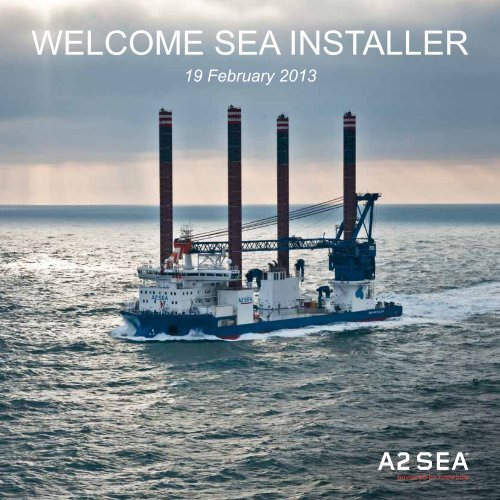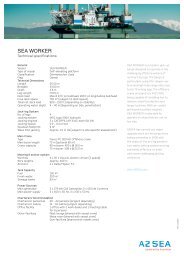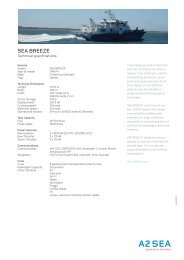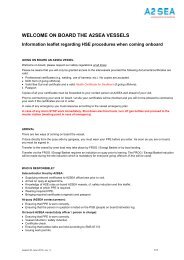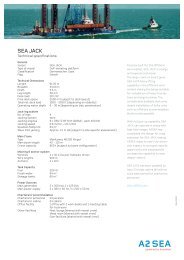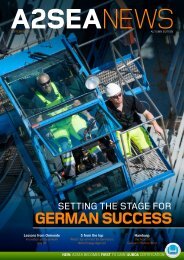WELCOME SEA INSTALLER - A2SEA
WELCOME SEA INSTALLER - A2SEA
WELCOME SEA INSTALLER - A2SEA
You also want an ePaper? Increase the reach of your titles
YUMPU automatically turns print PDFs into web optimized ePapers that Google loves.
<strong>WELCOME</strong> <strong>SEA</strong> <strong>INSTALLER</strong><br />
19 February 2013
<strong>WELCOME</strong> <strong>SEA</strong> <strong>INSTALLER</strong><br />
And welcome to you to this event which we have looked forward to for a long time!<br />
Today, Tuesday 19 February 2013, we celebrate our new vessel <strong>SEA</strong> <strong>INSTALLER</strong>. The vessel is one of the newest<br />
and most modern offshore wind installation vessels in the market right now. All the knowledge that A2<strong>SEA</strong> has gained<br />
as pioneers in the offshore wind business since the beginning in 2000 has been implemented into the vessel.<br />
This brochure gives you a thorough insight into the vessel and its technical capacity.<br />
Over the next 2 months, <strong>SEA</strong> <strong>INSTALLER</strong> will install turbines at Anholt Offshore Wind Park and afterwards she will<br />
be deployed in the Irish Sea on the project West of Duddon Sands until the summer of 2014.<br />
Thank you for celebrating <strong>SEA</strong> <strong>INSTALLER</strong> with us.<br />
Enjoy your tour on board the vessel.<br />
Best regards,<br />
Jens Frederik Hansen, CEO, A2<strong>SEA</strong> A/S<br />
IMPORTANT INFORMATION – SAFETY REGULATIONS<br />
Welcome on board <strong>SEA</strong> <strong>INSTALLER</strong>.<br />
Quality and safety are central to everything we do at A2<strong>SEA</strong> and all processes we carry out are characterised by the same objectives:<br />
Safety first, no accidents or incidents, no damage.<br />
Please respect our safety regulations.<br />
We have a smoking policy applying to all our vessels. Smoking is only allowed in designated areas outside. Please only walk in the designated<br />
areas.<br />
Fire alarm<br />
Continuous sounding of the alarm signal. The alarm is followed by an announcement on the PA (Public Address) system. Please pay attention. In<br />
case of a fire alarm you must leave the vessel immediately. Please obey instructions given by the vessel’s crew or the A2<strong>SEA</strong> staff.<br />
Enjoy your visit on board,<br />
HSEQ team<br />
Read more about our safety regulations on www.a2sea.com
• <strong>SEA</strong> <strong>INSTALLER</strong>’s deck measures 3350 square metres<br />
• The deck is reinforced and can carry 15 tons per square<br />
metre and a total load of 5000 tons<br />
• The vessel can accommodate eight 3.6 MW turbines or<br />
four 6MW turbines at a time<br />
• <strong>SEA</strong> <strong>INSTALLER</strong> was built at the COSCO shipyard in<br />
China under close supervision by A2<strong>SEA</strong>’s construction<br />
department<br />
• <strong>SEA</strong> <strong>INSTALLER</strong> measures 132 metres from stem to stern<br />
and the hull is 39 metres wide<br />
• <strong>SEA</strong> <strong>INSTALLER</strong> can operate at depths of between 6.5 and<br />
approx. 45 metres<br />
• <strong>SEA</strong> <strong>INSTALLER</strong> can work in three different modes:<br />
• Floating – as an ordinary vessel during transport<br />
and loading of turbine components<br />
• Semi-jacked-up during installation in fine weather<br />
or when soil conditions are difficult<br />
• Fully jacked-up during installation.<br />
• <strong>SEA</strong> <strong>INSTALLER</strong> weighs 20,000 tons fully loaded.<br />
DECK<br />
<strong>SEA</strong> <strong>INSTALLER</strong> is a state-of-the-art vessel based on our experience with<br />
the rest of the fleet, and the result is an ultra-modern and effective installation<br />
vessel. <strong>SEA</strong> <strong>INSTALLER</strong> is designed to meet the challenges that follow<br />
in the wake of market demands for ever larger wind turbines at increasing<br />
sea depths.<br />
From the deck of <strong>SEA</strong> <strong>INSTALLER</strong>, all wind turbine components are loaded<br />
from the quay and stored until the vessel reaches its destination at the offshore<br />
wind farm.<br />
The deck of <strong>SEA</strong> <strong>INSTALLER</strong> measures 3350 square metres, the size of<br />
half a football field.<br />
The deck has been specially designed for wind turbines in order to maximise<br />
the use of available space. As a result, the four jack-up legs are cylindershaped/round<br />
instead of the traditional triangular shape. This saves a large<br />
amount of space.<br />
The crane used to lift wind turbine components on and off <strong>SEA</strong> <strong>INSTALLER</strong><br />
is mounted round one of the legs, which also saves some space compared<br />
with the layout of our other vessels.<br />
For practical and safety reasons, all brackets and hatches are flush with the<br />
deck. The result is a completely uniform, flat surface, which makes it easier<br />
for the crew to move around without stumbling or falling, while minimising<br />
the risk of damaging wind turbine components or the vessel during loading.<br />
Compared with other installation vessels, the deck on <strong>SEA</strong> <strong>INSTALLER</strong> has<br />
been reinforced so it can carry 15 tons per square metre compared with the<br />
standard requirement of five tons per square metre. This makes it possible to<br />
load and transport larger wind turbine components, for example wind turbine<br />
towers and foundations.<br />
The size of the deck makes it possible to transport, for example, eight 3.6 MW<br />
turbines. The first installation vessel in the A2<strong>SEA</strong> fleet could accommodate<br />
four 1.8 MW turbines.<br />
CRANE<br />
The crane on <strong>SEA</strong> <strong>INSTALLER</strong> is the vessel’s workhorse. The crane is used<br />
to lift wind turbine components from the quay unto the vessel and to lift and<br />
position the components on site at the offshore wind farm.<br />
The electrical crane is of the GUSTO brand with a capacity of 800 tons at<br />
20 metres outreach or 600 tons at 30 metres outreach. The crane can also<br />
be adjusted to 2 x 400 tons dual lift in two individual lifting arrangements.<br />
With its current equipment and design, <strong>SEA</strong> <strong>INSTALLER</strong> is optimised to<br />
transport and install wind turbines of 3–6 MW but can also transport larger<br />
components.<br />
Very few turbine components weigh more than 300–400 tons, but the capacity<br />
of the crane makes it possible to handle wind turbine foundations<br />
weighing up to 800–900 tons.<br />
The lifting height is 100 metres from the deck or 120–130 metres measured<br />
from the surface of the sea if the height of the vessel is included.<br />
Due to the many heavy lifts, the <strong>SEA</strong> <strong>INSTALLER</strong> crane – like the rest of<br />
the vessel – has increased FATIGUE LIFETIME. The term reflects that all<br />
constructions and parts on the vessel have been reinforced to ensure high<br />
capacity and a long useful life.<br />
The lifting capacity at <strong>SEA</strong> <strong>INSTALLER</strong> has been optimised for large-scale<br />
offshore wind turbine projects but to further increase the capacity of the<br />
vessel, the crane will be updated within the next 2–3 years to raise the lifting<br />
capacity to 900 tons; the same capacity as the sister vessel NB 002 will<br />
have when delivered from the shipyard in 2014.<br />
<strong>SEA</strong> <strong>INSTALLER</strong> has the same capacity as A2<strong>SEA</strong>’s entire current fleet, and<br />
once the sister vessel NB 002 will be in operation in 2014, A2<strong>SEA</strong> will be in<br />
an even stronger position on the market for offshore wind turbine installation.<br />
• The crane on <strong>SEA</strong> <strong>INSTALLER</strong> is a GUSTO GLC-800-ED and<br />
fully electrical<br />
• The crane has a lifting capacity of 800 tons or 2 x 400 tons in<br />
dual lift<br />
• In addition to the main crane, <strong>SEA</strong> <strong>INSTALLER</strong> also has five<br />
smaller cranes<br />
• <strong>SEA</strong> <strong>INSTALLER</strong> will double A2<strong>SEA</strong>’s capacity compared with<br />
the current fleet.<br />
• The crane will be upgrated to a lifting capacity of 900 tons and<br />
a 120 meter boom in 2014
JACKING SYSTEM<br />
The four legs help giving <strong>SEA</strong> <strong>INSTALLER</strong> her characteristic appearance.<br />
When <strong>SEA</strong> <strong>INSTALLER</strong> is in the harbour, her legs are completely retracted,<br />
and when the vessel reaches its destination, the legs are lowered so they<br />
rest on the seabed. All this is controlled from the bridge.<br />
Raising or lowering the legs is called jacking up, which comes from the word<br />
jack. <strong>SEA</strong> <strong>INSTALLER</strong> thus operates by raising or lowering the four legs using<br />
a large number of jacks. During operation, the entire vessel is jacked up<br />
to the desired height with the deck typically around 15–25 metres above the<br />
surface of the sea. Once the task has been completed, the vessel is jacked<br />
down so it can sail normally.<br />
An effective jacking system is essential to enable a vessel like <strong>SEA</strong> <strong>INSTALLER</strong><br />
to operate and function effectively. <strong>SEA</strong> <strong>INSTALLER</strong> cannot sail during jacking<br />
and to avoid wasting too much time waiting, it is important to be able to<br />
raise and lower the legs as quickly as possible.<br />
• <strong>SEA</strong> <strong>INSTALLER</strong> has six<br />
3020 kilowatt engines<br />
• <strong>SEA</strong> <strong>INSTALLER</strong> has<br />
three Voight Schneider<br />
propellers for propulsion<br />
and three Bov propellers<br />
for satellite-based<br />
positioning<br />
• The vessel can<br />
manoeuvre with a precision<br />
of 25 cm under optimum<br />
weather conditions.<br />
The jacking system can raise a fully loaded <strong>SEA</strong> <strong>INSTALLER</strong> at a speed of<br />
approximately 1 metre per minute, which is twice as fast as standard jacking<br />
systems in the wind turbine industry.<br />
A single day is normally set aside for each offshore wind turbine, so<br />
it is important that the jacking system functions effectively and impeccably.<br />
<strong>SEA</strong> <strong>INSTALLER</strong> is fully functional even with two jacking cylinders<br />
out of operation at each leg, and, as with other constructions on<br />
<strong>SEA</strong> <strong>INSTALLER</strong>, much has been done to ensure optimum safety and<br />
durability.<br />
To make sure the legs rest firmly on the seabed, each leg has a so-called<br />
spudcan – like the sole of a shoe. The spudcan on the legs measures 108<br />
square metres per leg, so <strong>SEA</strong> <strong>INSTALLER</strong> has a solid 432 square metres<br />
footprint once the legs have been lowered.<br />
A special jetting system at the bottom of the legs can flush the legs free of the<br />
seabed when they have to be raised. Depending on the soil conditions, the<br />
legs may have penetrated up to 21 metres into the seabed, and without a jetting<br />
system, lifting the legs would be like pulling a gum boot out of a mud hole.<br />
• The jacking system on <strong>SEA</strong> <strong>INSTALLER</strong> is a double hydraulic<br />
system<br />
• There are eight jacking cylinders at each leg, i.e. 32 in total<br />
• The legs on <strong>SEA</strong> <strong>INSTALLER</strong> can be raised and lowered at a<br />
speed of 1 m/min<br />
• The legs on <strong>SEA</strong> <strong>INSTALLER</strong> are 84 metres long<br />
• The spudcan on the legs measures 108 square metres per leg, i.e.<br />
432 square metres in total.<br />
ENGINE ROOM<br />
No vessel is without an engine room. A huge amount of raw power is<br />
required on board <strong>SEA</strong> <strong>INSTALLER</strong>, so the engine room consists of three<br />
separate rooms, each equipped with two 3020 kilowatt diesel-electric engines.<br />
This gives a total of six engines with a combined capacity of more than<br />
18,000 kilowatt, generating high voltage power to propel the vessel, and<br />
for the jack-up system, the cranes and the many cooling, heating and<br />
ventilation systems on board. This is equivalent to the power required for<br />
2,5 million low energy light bulbs – if one should need that.<br />
Like the rest of <strong>SEA</strong> <strong>INSTALLER</strong>, the engine room is designed to optimise<br />
vessel operation. Even with two of the six engines out of operation, the<br />
vessel remains fully operational. In a worst case scenario, the vessel can<br />
sail with only one engine.<br />
The result is a large amount of raw power, not to mention a high degree<br />
of reliability of supply, which is essential when A2<strong>SEA</strong> counts on installing<br />
at least one wind turbine per day. While vessels in the oil and gas industry<br />
typically sail to a specific position, where they are jacked up and remain<br />
for shorter or longer periods of time, wind turbine installation vessels are<br />
constantly on the move, either to transport the turbines to their destination<br />
or in connection with installation.<br />
In addition to the engine power required to sail <strong>SEA</strong> <strong>INSTALLER</strong>, the engine<br />
room supplies power to a special satellite-based navigation system<br />
also called DP (Dynamic Positioning), which can maintain a given position<br />
during operation with a tolerance of only 25 cm.
CONTROL ROOM<br />
An installation vessel like <strong>SEA</strong> <strong>INSTALLER</strong> has many electrical and pressurised<br />
systems, from the vessel’s engines to the hydraulic jack-up system,<br />
ventilation systems, cooling systems and toilets, not to mention service<br />
water for up to 60 people. Everything is controlled from the control room<br />
on <strong>SEA</strong> <strong>INSTALLER</strong>.<br />
It is therefore not just cranes and engines that need to function. There<br />
are tanks for drinking water and sewage; the vessel’s ventilation and airconditioning<br />
systems provide fresh air and the right temperature on board,<br />
and the cooling room in the galley obviously has to function as well. All these<br />
systems and processes are monitored and controlled from the control room.<br />
• The mess on <strong>SEA</strong> <strong>INSTALLER</strong><br />
is open 24/7<br />
• It is prohibited to drink<br />
alcohol on board<br />
<strong>SEA</strong> <strong>INSTALLER</strong><br />
• A special office is available<br />
where guests on board the<br />
vessel can work undisturbed.<br />
To be the chief engineer on board <strong>SEA</strong> <strong>INSTALLER</strong> is like being responsible<br />
for processes and systems in a small Danish village. To help the chief<br />
engineer with the monitoring, <strong>SEA</strong> <strong>INSTALLER</strong> has installed an Integrated<br />
Control Ship System (ICSS).<br />
The advanced computer-based ICSS system helps monitor and control<br />
temperature, power consumption, water consumption and oil pressure.<br />
CHANGING ROOMS AND GYM FACILITIES<br />
<strong>SEA</strong> <strong>INSTALLER</strong> can accommodate 60 people, including crew and guests.<br />
Installing offshore wind turbines can be a wet and dirty job, so the crew<br />
needs good facilities for changing and showering – we call this the Comfort<br />
Zone. The Comfort Zone is where the crew changes from work clothes to<br />
leisure wear, and facilities are provided for relaxation and exercise before<br />
continuing to the lounge area or private cabins.<br />
It is prohibited to take work clothes to the individual cabins. We therefore<br />
also have a Clean Zone, where it is not permitted to wear work clothes.<br />
The changing room facilities make it clear that <strong>SEA</strong> <strong>INSTALLER</strong> maintains<br />
a high standard throughout the Comfort Zone. In addition to being pleasant<br />
for the crew, it is also important when the crew is unable to do anything but<br />
wait during bad weather.<br />
For the same reason, much attention has been paid to the gym facilities.<br />
Here the crew has plenty of opportunities for weightlifting and fitness training<br />
if the wait becomes too long.<br />
MESS, GALLEY AND CINEMA<br />
At A2<strong>SEA</strong> we have always employed our own experienced crews just like<br />
we operate our own fleet. This gives us maximum control and means we<br />
can ensure the highest standards of safety and quality.<br />
However, being a crew member on an installation vessel like <strong>SEA</strong> <strong>INSTALLER</strong><br />
can be a challenging job, both physically and mentally. We spoil our crew<br />
members when they are off duty, and we do so at what we call our Recreational<br />
Deck – the area on <strong>SEA</strong> <strong>INSTALLER</strong> which comprises mess,<br />
galley and cinema.<br />
The mess is a natural gathering point because the work gives a good appetite.<br />
The mess is open 24/7 while the vessel is working on a job. Here<br />
you do not find fancy food in very small portions; instead we serve good,<br />
honest food, large steaks and plenty of accompaniments on a par with<br />
well-known restaurants on shore.<br />
It is prohibited to drink alcohol on board, but the crew can consume anything<br />
from soft drinks and juice to coffee and other hot drinks.<br />
<strong>SEA</strong> <strong>INSTALLER</strong> also gives the crew the option of watching films, as the<br />
vessel has a cinema where the crew can choose the films they want to<br />
watch.<br />
Finally, we have a department with an office where guests on board the<br />
vessel can work undisturbed. The office is popular as we often have customers,<br />
suppliers, experts and other guests on board.
• <strong>SEA</strong> <strong>INSTALLER</strong> can<br />
accommodate 60 crew<br />
members and guests<br />
• Everyone on board has a<br />
single cabin<br />
• The crew and any customers<br />
on board share the same<br />
lounge and cabins<br />
• It is not permitted to wear<br />
work clothes in the lounge<br />
area and in the cabins.<br />
BRIDGE<br />
The tour of <strong>SEA</strong> <strong>INSTALLER</strong> finishes in the penthouse apartment – the<br />
bridge, a 285 m2 large top-modern wheel house with the latest communication<br />
and navigation equipment.<br />
The bridge is a tailor-made construction and reaches beyond both railings.<br />
From here you have a good view of the cargo, the crane as well as the<br />
harbour – a considerable improvement compared with former installation<br />
vessels. In addition, the design has taken the finer details into account, and<br />
the advanced satellite navigation equipment makes it possible to manoeuvre<br />
<strong>SEA</strong> <strong>INSTALLER</strong> with 25 cm precision.<br />
<strong>SEA</strong> <strong>INSTALLER</strong> can be operated from control panels placed on different<br />
parts of the bridge; the vessel has a front bridge, two side bridges and a<br />
rear bridge. To this should be added a control panel for the crane and the<br />
jack-up systems. It is often the same person who manoeuvres the vessel<br />
and operates the jack-up systems.<br />
LOUNGE AND CABINS<br />
<strong>SEA</strong> <strong>INSTALLER</strong> has accommodation for 60 people staying in single<br />
cabins. It is important to us that <strong>SEA</strong> <strong>INSTALLER</strong> is a state-of-the-art<br />
vessel using the latest technology, and on one important point we break<br />
with traditions: the fitting out of the cabins.<br />
The design of <strong>SEA</strong> <strong>INSTALLER</strong> has focused on providing single cabins<br />
for everyone. Rather than fewer, larger cabins accommodating several<br />
crew members, as is often the case in the oil and gas industry, the<br />
cabins on <strong>SEA</strong> <strong>INSTALLER</strong> are smaller but they afford the crew some<br />
privacy.<br />
We call it the One Team concept. We believe that if you eat and relax<br />
together, you also work better together. The lounge area is therefore<br />
shared by everyone on board.<br />
The lounge area and the cabins have effective sound insulation so the<br />
crew can relax or sleep without being disturbed by the work on board.<br />
Master Brian Rudi Bendixen<br />
At first sight, an important thing seems to be missing on the bridge: there<br />
are no large charts on the desk with pencil and sextant markings.Today,<br />
navigation is by satellite; everything is electronic and there is actually not a<br />
single paper chart on board <strong>SEA</strong> <strong>INSTALLER</strong>.<br />
As a second generation installation vessel, <strong>SEA</strong> <strong>INSTALLER</strong> is a top-modern<br />
vessel which is based on experience acquired during many hours of<br />
work on our other vessels. The vessel has a higher installation speed than<br />
previous vessels and the crane a larger boom length, making the vessel<br />
more efficient than other installation vessels. To this should be added that<br />
<strong>SEA</strong> <strong>INSTALLER</strong> is incredibly hard-wearing as a result of her reinforced<br />
construction and optimised processes.<br />
A2<strong>SEA</strong> moreover has a committed and highly competent team of seamen<br />
and experts in the installation of offshore wind turbines on board, which<br />
allows us to state with conviction that:<br />
<strong>SEA</strong> <strong>INSTALLER</strong> is the installation vessel for the future wind turbine<br />
industry.<br />
If the accommodation on <strong>SEA</strong> <strong>INSTALLER</strong> had been designed for<br />
the oil and gas industry, the vessel could have accommodated more<br />
people. On board <strong>SEA</strong> <strong>INSTALLER</strong> our crew and customers have<br />
single cabins.<br />
In addition, the lounge area where the crew can relax is shared by<br />
crew and any customers on board. There are no special facilities for<br />
VIPs that can be the source of envy.<br />
• <strong>SEA</strong> <strong>INSTALLER</strong> can be manoeuvred from the bridge by a single<br />
person<br />
• The bridge is 50 metres wide and the total area measures 285 m2<br />
• There are five control panels on the bridge from where the vessel<br />
can be manoeuvred<br />
• <strong>SEA</strong> <strong>INSTALLER</strong> can be manoeuvred in the so-called DP2 mode
<strong>SEA</strong> <strong>INSTALLER</strong><br />
specifications<br />
Technical specifications<br />
General<br />
Vessel<br />
Type of vessel<br />
DP2<br />
Classification<br />
Flag<br />
<strong>SEA</strong> <strong>INSTALLER</strong><br />
Self-propelled jack-up vessel<br />
(at charterer’s request)<br />
DNV<br />
Danish<br />
Technical Dimensions<br />
Length<br />
132 m<br />
Breadth<br />
39 m<br />
Draft<br />
5.3 m<br />
Leg length<br />
83 m<br />
Deck load<br />
15 t/m²<br />
Free deck space 3350 m² (subject to deck layout)<br />
Total net deck load 5000 t (depending on stability)<br />
Service speed<br />
12 kn Max<br />
Operating water depth 6.5 - 45 m (depending on tide, penetration)<br />
Jack-leg System<br />
No. of legs 4<br />
Jacking system Double Hydraulic System<br />
Jacking speed<br />
0.50 m/min<br />
Spudcan footprint 105 m²<br />
Wave limit jacking 2.0 m Hs (subject to site specific assessment)<br />
Main Crane<br />
Type<br />
Gusto GLC-800-ED<br />
Main boom length 94 m<br />
Max crane capacity 800 t @ 24 m outreach (600 t@30m)<br />
(optional up to 900 t subject to boom configuration)<br />
Cargo Crane<br />
Type<br />
Marine cranes<br />
No. of cargo cranes 5<br />
Main boom length 25 m<br />
Max crane capacity 20 t<br />
Tank Capacity<br />
Fuel 1000 m³<br />
Fresh water 450 m³<br />
Sewage tanks 300 m³<br />
<strong>SEA</strong> <strong>INSTALLER</strong> is based on year’s<br />
of experience in this market and<br />
is a huge step forward in capacity<br />
and possibilities. This vessel can<br />
work in three main “modes“ and is<br />
self propelled and fitted with accommodation<br />
for two full installation<br />
crews:<br />
• Floating crane vessel with<br />
restricted crane loads<br />
• Semi Jacked up vessel with<br />
reduced load on the legs for<br />
harbour use and on sites with<br />
difficult soil conditions<br />
• Fully jacked up vessel<br />
We have focused on making a vessel<br />
with excellent crane position<br />
to maximize the usage of the deck<br />
area and minimise handling of the<br />
cargo onshore and offshore. The<br />
vessel is built for operations in<br />
tidal areas and difficult soil conditions.<br />
Visit A2<strong>SEA</strong>.com<br />
Power Sources<br />
Main engines<br />
Power supply<br />
6 x 3020 kW<br />
6.6 kV, 400V, 230V, 110V, 50 Hz<br />
Charterers’ Accommodation<br />
Charterers’ personnel 35 persons<br />
Charterers’ cabins 35 single cabins<br />
Office facility<br />
2 offices with 6 work desk<br />
Other facilities Rest lounge (shared with vessel crew)<br />
Mess room (shared with vessel crew)<br />
Gym facilities (shared with vessel crew)<br />
REV: 120620
Scan and watch installation at<br />
Gunfleet Sands 3


